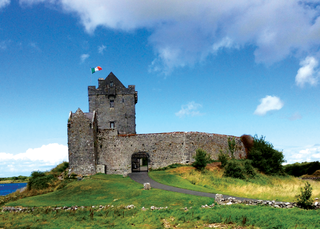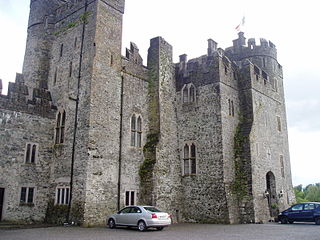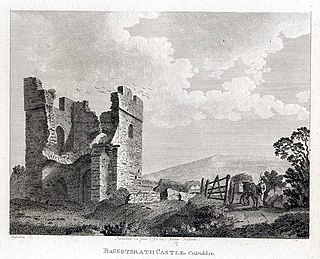
Baron Bellew, of Barmeath in the County of Louth, is a title in the Peerage of Ireland. It was created on 17 July 1848 for Sir Patrick Bellew, 7th Baronet, who had previously represented Louth in the House of Commons as a Whig and also served as Lord Lieutenant of County Louth. His grandson, the third Baron, was also Lord Lieutenant of County Louth and sat in the House of Lords as an Irish Representative Peer from 1904 to 1911. He was succeeded by his younger brother, the fourth Baron. He was an Irish Representative Peer from 1914 to 1931. In 1881 Lord Bellew assumed by Royal licence the additional surname of Bryan under the terms of the will of his maternal uncle Colonel George Bryan. However, he is the only one of the Barons to have held this surname. On his death the titles passed to his nephew, the fifth Baron, and then to his younger brother, the sixth Baron. As of 2018 the titles are held by the latter's grandson, the eighth Baron, who succeeded in 2010.

Dunamase or The Rock of Dunamase is a rocky outcrop in the townland of Park or Dunamase in County Laois. The rock, 46 metres (151 ft) above a flat plain, has the ruins of Dunamase Castle, a defensive stronghold dating from the early Hiberno-Norman period with a view across to the Slieve Bloom Mountains. It is near the N80 road between the towns of Portlaoise and Stradbally.

St. Peter's Roman Catholic Church is located on West Street, Drogheda, County Louth, Ireland. Designed by J. O'Neill and W.H. Byrne and built in the French Gothic style of local limestone ashlar in 1884. The church is famous for its tall west gable, rose window and for containing the national shrine of St. Oliver Plunkett.

Dunguaire Castle is a 16th-century tower house on the southeastern shore of Galway Bay in County Galway, Ireland, near Kinvara. The name derives from the Dun of King Guaire, the legendary king of Connacht. The castle's 75-foot (23 m) tower and its defensive wall have been restored, and the grounds are open to tourists during the summer.

Durhamstown Castle is a 600-year-old towerhouse in the townland of Durhamstown of the civil parish of Ardbraccan which is in the barony (Ireland) of Lower Navan, in County Meath, Ireland. It is named after a Mr Doream and has been converted into a guest house and restaurant.

Rossmore Castle, also known as Rossmore Park, was a castle on the outskirts of Monaghan in County Monaghan, Ireland. It was built in the Gothic style in 1827 and was the seat of the Barons Rossmore, but fell into disrepair in the 1940s when the family moved to Camla Vale, and was demolished in the 1970s.
Ballymount, is a locality on the south side of Dublin, near the mainly residential areas of Walkinstown to the east, Tallaght to the west and Greenhills to the south. Ballymount is accessed by a number of public bus routes from Dublin city centre, and via the Red Cow Stop on the Red Luas Line, and it houses one of the largest industrial zones in Ireland.

Kilkea Castle is located 5 km (3.1 mi) northwest of Castledermot, County Kildare, Ireland near the village of Kilkea on the R418 regional road from Athy to Tullow. It was a medieval stronghold of the Fitzgeralds, earls of Kildare.
Ballinlough Castle is a 17th-century country house situated near the rural town of Clonmellon in County Westmeath, Ireland on a hill overlooking two of the Westmeath lakes. It is the home of Sir Nicholas and Lady Nugent.
Patrick Bellew, 1st Baron Bellew PC (Ire), known as Sir Patrick Bellew, 7th Baronet, from 1827 to 1848, was an Irish Whig politician.

Newcastle is a village in south-west South Dublin, Ireland. It is also a civil parish in the barony of the same name. It was the location of the castle of the barony, which in historical and official documents is described as Newcastle-Lyons. The area is still primarily rural in nature.
Darver Castle is a fortified tower and manor house located in Readypenny, Dundalk, County Louth, Republic of Ireland, dating back to the 12th century. The name "Darver" is derived from the Gaelic word "Dairbhe" meaning "Oakwood."

Dardistown Castle is a castle and country house situated in parkland near Julianstown in County Meath, Ireland a few miles south of Drogheda.

Fiddaun Castle is a tower house in Tubber, County Galway, close to the border of County Clare in Ireland. It is a National Monument of Ireland.
Louth was a constituency represented in the Irish House of Commons to 1801.
The High Sheriff of Louth was the Crown's representative for County Louth, a territory known as his bailiwick. Selected from three nominated people, he held his office over the duration of a year. He had judicial, ceremonial and administrative functions and executed High Court Writs.

Baggotrath Castle, or Baggotsrath Castle, was a castle situated at present-day Baggot Street in Dublin city centre. It was built in the late thirteenth century by the Bagod family, for whom it was named.

Menlo Castle or Menlough Castle, also called Blake's Castle, is a 16th century castle situated on the bank of the River Corrib near Menlo village in County Galway, Ireland.

Carbury Castle is a castle situated in the townland of Carbury, on the borders of Kildare and Offaly. The area is dominated by the ruins of this great Tudor mansion set atop Carbury Hill, which was also known as Fairy Hill. The motte on the hill was probably built by Meiler FitzHenry who was granted the area by Strongbow. It was acquired by the de Berminghams in the 14th century, before being taken by the native Irish in the 15th century. In 1588 it was granted to the Colley family, ancestors of the Dukes of Wellington, who built a large stronghouse in the 17th century.

Jenkinstown Castle was a country house using designs by William Robertson which incorporated the earlier Palladian building (pre-1798). This structure was built for Sir Patrick Bellew (1798-1866), first Baron Bellew of Barmeath at Jenkinstown Park, County Kilkenny, Ireland. However the design had serious structural issues and the Bellews hired architect Charles Frederick Anderson to remedy the situation. However some of that structure collapsed. The architect left Ireland and moved to the USA. The house was restored in a smaller version and remained occupied by the Bellew family until the 1930s.














